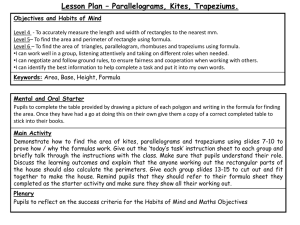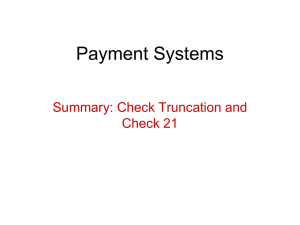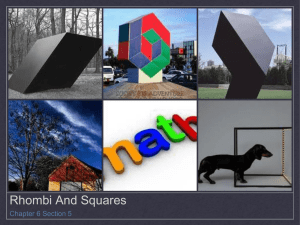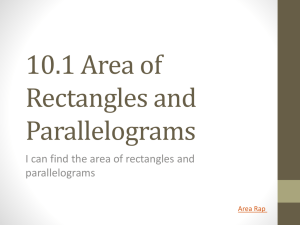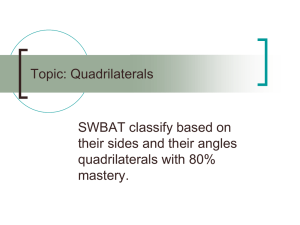Polygons - Denise Kapler
advertisement
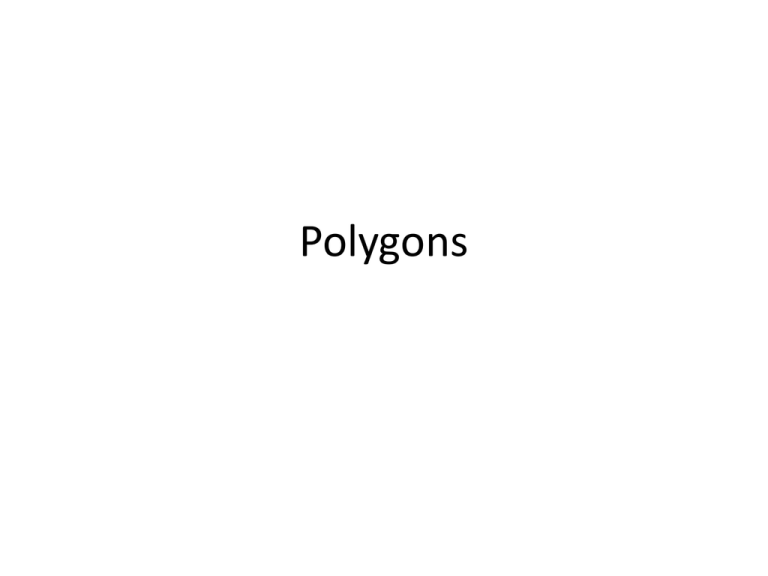
Polygons Why a hexagon? Polygon comes from Greek. poly- means "many" -gon means "angle" Polygons 1. 2-dimensional shapes 2. made of straight lines 3. Shape is "closed" (all the lines connect up). Polygon – classified by sides and angles Polygon (straight sides) Convex Not a Polygon (has a curve) Not a Polygon (open, not closed) Concave If there are any internal angles greater than 180° then it is concave. Regular Irregular Regular - all angles are equal and all sides are equal Simple Polygon (this one's a Pentagon) Complex Polygon (also a Pentagon) complex polygon intersects itself Convex Concave Regular polygons Not regular polygons Concave Octagon Complex Polygon (a "star polygon", in this case, a pentagram) Irregular Hexagon Common polygons 4 5 6 7 8 10 12 Sides Quadrilateral Pentagon Hexagon Heptagon Octagon Decagon Dodecagon Name 9 11 Nonagon, Enneagon Undecagon, Hendecagon 13 Tridecagon, Triskaidecagon 14 Tetradecagon, Tetrakaidecagon 15 Pentadecagon, Pentakaidecagon 16 Hexadecagon, Hexakaidecagon 17 Heptadecagon, Heptakaidecagon 18 Octadecagon, Octakaidecagon 19 Enneadecagon, Enneakaidecagon 20 Icosagon Sides Name 9 11 Nonagon, Enneagon Undecagon, Hendecagon 13 Tridecagon, Triskaidecagon 14 Tetradecagon, Tetrakaidecagon 15 Pentadecagon, Pentakaidecagon 16 Hexadecagon, Hexakaidecagon 17 Heptadecagon, Heptakaidecagon 18 Octadecagon, Octakaidecagon 19 Enneadecagon, Enneakaidecagon 20 Icosagon 30 Triacontagon 40 Tetracontagon 50 Pentacontagon 60 Hexacontagon 70 Heptacontagon 80 Octacontagon 90 Enneacontagon 100 Hectogon, Hecatontagon 1,000 Chiliagon 10,000 Myriagon Each segment that forms a polygon is a side of the polygon. The common endpoint of two sides is a vertex of the polygon. A segment that connects any two nonconsecutive vertices is a diagonal. Quadrilateral The sum of the angles of a quadrilateral is 360 degrees Parallelogram A four-sided polygon with two pairs of parallel sides. The sum of the angles of a parallelogram is 360 degrees Rectangle A four-sided polygon having all right angles. The sum of the angles of a rectangle is 360 degrees. Square A four-sided polygon having equal-length sides meeting at right angles. The sum of the angles of a square is 360 degrees Rhombus A four-sided polygon having all four sides of equal length. The sum of the angles of a rhombus is 360 degrees. Trapezoid A four-sided polygon having exactly one pair of parallel sides. The two sides that are parallel are called the bases of the trapezoid. The sum of the angles of a trapezoid is 360 degrees. Triangle A three-sided polygon. The sum of the angles of a triangle is 180 degrees. Equilateral Triangle or Equiangular Triangle A triangle having all three sides of equal length. The angles of an equilateral triangle all measure 60 degrees. Isosceles Triangle A triangle having two sides of equal length. Scalene Triangle A triangle having three sides of different lengths. Acute Triangle A triangle having three acute angles. Obtuse Triangle A triangle having an obtuse angle. One of the angles of the triangle measures more than 90 degrees. Right Triangle A triangle having a right angle. One of the angles of the triangle measures 90 degrees. The side opposite the right angle is called the hypotenuse. The two sides that form the right angle are called the legs. Pythagorean Theorem A right triangle has the special property that the sum of the squares of the lengths of the legs equals the square of the length of the hypotenuse. http://www.mathplayground.com/matching_shapes.html Quadrilateral Identifying Polygons If it is a polygon, name it by the number of sides. polygon, hexagon Identifying Polygons If it is a polygon, name it by the number of sides. polygon, heptagon Identifying Polygons If it is a polygon, name it by the number of sides. not a polygon Identifying Polygons If it is a polygon, name it by the number of its sides. not a polygon Identifying Polygons If it is a polygon, name it by the number of its sides. polygon, nonagon Identifying Polygons If it is a polygon, name it by the number of its sides. not a polygon A polygon is concave if any part of a diagonal contains points in the exterior of the polygon. If no diagonal contains points in the exterior, then the polygon is convex. A regular polygon is always convex. Classifying Polygons Regular or irregular? Concave or convex? irregular, convex Classifying Polygons Regular or irregular? Concave or convex? irregular, concave Classifying Polygons Regular or irregular? Concave or convex? regular, convex Classifying Polygons Regular or irregular? Concave or convex? regular, convex Classifying Polygons Regular or irregular? Concave or convex? irregular, concave To find the sum of the interior angle measures of a convex polygon, draw all possible diagonals from one vertex of the polygon. This creates a set of triangles. The sum of the angle measures of all the triangles equals the sum of the angle measures of the polygon. By the Triangle Sum Theorem, the sum of the interior angle measures of a triangle is 180°. Example 3A: Finding Interior Angle Measures and Sums in Polygons Find the sum of the interior angle measures of a convex heptagon. (n – 2)180° Polygon Sum Thm. (7 – 2)180° A heptagon has 7 sides, so substitute 7 for n. 900° Simplify. Example 3B: Finding Interior Angle Measures and Sums in Polygons Find the measure of each interior angle of a regular 16-gon. Step 1 Find the sum of the interior angle measures. (n – 2)180° Polygon Sum Thm. Substitute 16 for n and simplify. (16 – 2)180° = 2520° Step 2 Find the measure of one interior angle. The int. s are , so divide by 16. Example 3C: Finding Interior Angle Measures and Sums in Polygons Find the measure of each interior angle of pentagon ABCDE. Polygon Sum Thm. (5 – 2)180° = 540° mA + mB + mC + mD + mE = 540° 35c + 18c + 32c + 32c + 18c = 540 135c = 540 c=4 Combine like terms. Divide both sides by 135. Polygon Sum Thm Substitute. Example 3C Continued mA = 35(4°) = 140° mB = mE = 18(4°) = 72° mC = mD = 32(4°) = 128° Example 4 Find the sum of the interior angle measures of a convex 15-gon. (n – 2)180° Polygon Sum Thm. (15 – 2)180° A 15-gon has 15 sides, so substitute 15 for n. 2340° Simplify. Example 5 Find the measure of each interior angle of a regular decagon. Step 1 Find the sum of the interior angle measures. (n – 2)180° Polygon Sum Thm. Substitute 10 for n and simplify. (10 – 2)180° = 1440° Step 2 Find the measure of one interior angle. The int. s are , so divide by 10. In the polygons below, an exterior angle has been measured at each vertex. Notice that in each case, the sum of the exterior angle measures is 360°. Example 6: Finding Interior Angle Measures and Sums in Polygons Find the measure of each exterior angle of a regular 20-gon. A 20-gon has 20 sides and 20 vertices. sum of ext. s = 360°. measure of one ext. = Polygon Sum Thm. A regular 20-gon has 20 ext. s, so divide the sum by 20. The measure of each exterior angle of a regular 20-gon is 18°. Example 7: Finding Interior Angle Measures and Sums in Polygons Find the value of b in polygon FGHJKL. Polygon Ext. Sum Thm. 15b° + 18b° + 33b° + 16b° + 10b° + 28b° = 360° 120b = 360 b=3 Combine like terms. Divide both sides by 120. Example 8 Find the measure of each exterior angle of a regular dodecagon. A dodecagon has 12 sides and 12 vertices. sum of ext. s = 360°. measure of one ext. Polygon Sum Thm. A regular dodecagon has 12 ext. s, so divide the sum by 12. The measure of each exterior angle of a regular dodecagon is 30°. Example 9 Find the value of r in polygon JKLM. 4r° + 7r° + 5r° + 8r° = 360° 24r = 360 r = 15 Combine like terms. Divide both sides by 24. Polygon Ext. Sum Thm. Example 10: Art Application Ann is making paper stars for party decorations. What is the measure of 1? 1 is an exterior angle of a regular pentagon. By the Polygon Exterior Angle Sum Theorem, the sum of the exterior angles measures is 360°. A regular pentagon has 5 ext. , so divide the sum by 5. Find the value of each variable. 1. x 2. y 2 3. z 4 18 Objectives Prove and apply properties of parallelograms. Use properties of parallelograms to solve problems. A quadrilateral with two pairs of parallel sides is a parallelogram. To write the name of a parallelogram, you use the symbol . If a quadrilateral is a parallelogram • its opposite sides are congruent • its opposite angles are congruent • its consecutive angles are supplementary If a quadrilateral is a parallelogram • diagonals bisect each other • each diagonal splits the parallelogram into two congruent triangles. http://www.ies.co.jp/math/products/geo1/applets/para/para.html http://www.mathwarehouse.com/geometry/quadrilaterals/parallelograms/ Example 1: Properties of Parallelograms In CDEF, DE = 74 mm, DG = 31 mm, and mFCD = 42°. Find CF. opp. sides CF = DE Def. of segs. CF = 74 mm Substitute 74 for DE. Example 2: Properties of Parallelograms In CDEF, DE = 74 mm, DG = 31 mm, and mFCD = 42°. Find mEFC. mEFC + mFCD = 180° mEFC + 42 = 180 mEFC = 138° cons. s supp. Substitute 42 for mFCD. Subtract 42 from both sides. Example 3: Properties of Parallelograms In CDEF, DE = 74 mm, DG = 31 mm, and mFCD = 42°. Find DF. DF = 2DG diags. bisect each other. DF = 2(31) Substitute 31 for DG. DF = 62 Simplify. Example 4 In KLMN, LM = 28 in., LN = 26 in., and mLKN = 74°. Find KN. opp. sides LM = KN Def. of segs. LM = 28 in. Substitute 28 for DE. Example 5 In KLMN, LM = 28 in., LN = 26 in., and mLKN = 74°. Find mNML. NML LKN opp. s mNML = mLKN Def. of s. mNML = 74° Substitute 74° for mLKN. Def. of angles. Example 6 In KLMN, LM = 28 in., LN = 26 in., and mLKN = 74°. Find LO. LN = 2LO diags. bisect each other. 26 = 2LO Substitute 26 for LN. LO = 13 in. Simplify. Example 7: Using Properties of Parallelograms to Find Measures WXYZ is a parallelogram. Find YZ. opp. s Def. of segs. YZ = XW 8a – 4 = 6a + 10 2a = 14 a=7 Substitute the given values. Subtract 6a from both sides and add 4 to both sides. Divide both sides by 2. YZ = 8a – 4 = 8(7) – 4 = 52 Example 8: Using Properties of Parallelograms to Find Measures WXYZ is a parallelogram. Find mZ . cons. s supp. mZ + mW = 180° (9b + 2) + (18b – 11) = 180 Substitute the given values. 27b – 9 = 180 27b = 189 b=7 mZ = (9b + 2)° = [9(7) + 2]° = 65° Combine like terms. Add 9 to both sides. Divide by 27. Example 9 EFGH is a parallelogram. Find JG. diags. bisect each other. EJ = JG 3w = w + 8 2w = 8 w=4 JG = w + 8 = 4 + 8 = 12 Def. of segs. Substitute. Simplify. Divide both sides by 2. Example 10 EFGH is a parallelogram. Find FH. diags. bisect each other. FJ = JH 4z – 9 = 2z 2z = 9 z = 4.5 Def. of segs. Substitute. Simplify. Divide both sides by 2. FH = (4z – 9) + (2z) = 4(4.5) – 9 + 2(4.5) = 18 When you are drawing a figure in the coordinate plane, the name ABCD gives the order of the vertices. Example 11 In PNWL, NW = 12, PM = 9, and mWLP = 144°. Find each measure. 1. PW 18 2. mPNW 144° Example 12 QRST is a parallelogram. Find each measure. 2. TQ 28 3. mT 71° Example 13 Three vertices of ABCD are A (2, –6), B (–1, 2), and C(5, 3). Find the coordinates of vertex D. (8, –5) Practice Justify each statement. 1. Reflex Prop. of 2. Conv. of Alt. Int. s Thm. Evaluate each expression for x = 12 and y = 8.5. 3. 2x + 7 31 4. 16x – 9 183 5. (8y + 5)° 73° Practice Solve for x. 1. 16x – 3 = 12x + 13 2. 2x – 4 = 90 4 47 ABCD is a parallelogram. Find each measure. 3. CD 4. mC 14 104° Objectives Prove and apply properties of rectangles, rhombuses, and squares. Use properties of rectangles, rhombuses, and squares to solve problems. A second type of special quadrilateral is a rectangle. A rectangle is a quadrilateral with four right angles. Since a rectangle is a parallelogram by Theorem 6-4-1, a rectangle “inherits” all the properties of parallelograms that you learned in Lesson 6-2. Example 1: Craft Application A woodworker constructs a rectangular picture frame so that JK = 50 cm and JL = 86 cm. Find HM. Rect. diags. KM = JL = 86 Def. of segs. diags. bisect each other Substitute and simplify. Example 1a Carpentry The rectangular gate has diagonal braces. Find HJ. Rect. diags. HJ = GK = 48 Def. of segs. Example 1b Carpentry The rectangular gate has diagonal braces. Find HK. Rect. diags. Rect. diagonals bisect each other JL = LG JG = 2JL = 2(30.8) = 61.6 Def. of segs. Substitute and simplify. A rhombus is another special quadrilateral. A rhombus is a quadrilateral with four congruent sides. Like a rectangle, a rhombus is a parallelogram. So you can apply the properties of parallelograms to rhombuses. Example 2A: Using Properties of Rhombuses to Find Measures TVWX is a rhombus. Find TV. WV = XT 13b – 9 = 3b + 4 10b = 13 b = 1.3 Def. of rhombus Substitute given values. Subtract 3b from both sides and add 9 to both sides. Divide both sides by 10. Example 2A Continued TV = XT Def. of rhombus TV = 3b + 4 Substitute 3b + 4 for XT. TV = 3(1.3) + 4 = 7.9 Substitute 1.3 for b and simplify. Example 2B: Using Properties of Rhombuses to Find Measures TVWX is a rhombus. Find mVTZ. mVZT = 90° 14a + 20 = 90° a=5 Rhombus diag. Substitute 14a + 20 for mVTZ. Subtract 20 from both sides and divide both sides by 14. Example 2B Continued mVTZ = mZTX Rhombus each diag. bisects opp. s mVTZ = (5a – 5)° Substitute 5a – 5 for mVTZ. mVTZ = [5(5) – 5)]° = 20° Substitute 5 for a and simplify. Example 2a CDFG is a rhombus. Find CD. CG = GF 5a = 3a + 17 a = 8.5 GF = 3a + 17 = 42.5 Def. of rhombus Substitute Simplify Substitute CD = GF Def. of rhombus CD = 42.5 Substitute Example 2b CDFG is a rhombus. Find the measure. mGCH if mGCD = (b + 3)° and mCDF = (6b – 40)° Def. of rhombus mGCD + mCDF = 180° b + 3 + 6b – 40 = 180° Substitute. 7b = 217° b = 31° Simplify. Divide both sides by 7. Example 2b Continued mGCH + mHCD = mGCD 2mGCH = mGCD Rhombus each diag. bisects opp. s 2mGCH = (b + 3) Substitute. 2mGCH = (31 + 3) Substitute. mGCH = 17° Simplify and divide both sides by 2. A square is a quadrilateral with four right angles and four congruent sides. In the exercises, you will show that a square is a parallelogram, a rectangle, and a rhombus. So a square has the properties of all three. Example 3: Verifying Properties of Squares Show that the diagonals of square EFGH are congruent perpendicular bisectors of each other. Example 3 Continued Step 1 Show that EG and FH are congruent. Since EG = FH, Example 3 Continued Step 2 Show that EG and FH are perpendicular. Since , Example 3 Continued Step 3 Show that EG and FH are bisect each other. Since EG and FH have the same midpoint, they bisect each other. The diagonals are congruent perpendicular bisectors of each other. Example 4 The vertices of square STVW are S(–5, –4), T(0, 2), V(6, –3) , and W(1, –9) . Show that the diagonals of square STVW are congruent perpendicular bisectors of each other. SV = TW = 122 so, SV TW . 1 slope of SV = 11 slope of TW = –11 SV TW Example 4 Continued Step 1 Show that SV and TW are congruent. Since SV = TW, Example 4 Continued Step 2 Show that SV and TW are perpendicular. Since Example 4 Continued Step 3 Show that SV and TW bisect each other. Since SV and TW have the same midpoint, they bisect each other. The diagonals are congruent perpendicular bisectors of each other. Example 5: Using Properties of Special Parallelograms in Proofs Given: ABCD is a rhombus. E is the midpoint of F is the midpoint of , and . Prove: AEFD is a parallelogram. Example 5 Continued || Example 6 Given: PQTS is a rhombus with diagonal Prove: Example 6 Continued Statements Reasons 1. PQTS is a rhombus. 1. Given. 2. 2. Rhombus → each diag. bisects opp. s 3. QPR SPR 3. Def. of bisector. 4. 4. Def. of rhombus. 5. 5. Reflex. Prop. of 6. 6. SAS 7. 7. CPCTC Example 7 A slab of concrete is poured with diagonal spacers. In rectangle CNRT, CN = 35 ft, and NT = 58 ft. Find each length. 1. TR 2. CE 35 ft 29 ft Example 8 PQRS is a rhombus. Find each measure. 3. QP 42 4. mQRP 51° Example 9 The vertices of square ABCD are A(1, 3), B(3, 2), C(4, 4), and D(2, 5). Show that its diagonals are congruent perpendicular bisectors of each other. Example 10 Given: ABCD is a rhombus. Prove: ABE CDF Practice 1. Find AB for A (–3, 5) and B (1, 2). 5 2. Find the slope of JK for J(–4, 4) and K(3, –3). –1 ABCD is a parallelogram. Justify each statement. 3. ABC CDA 4. AEB CED opp. s Vert. s Thm. Objective Prove that a given quadrilateral is a rectangle, rhombus, or square. When you are given a parallelogram with certain properties, you can use the theorems below to determine whether the parallelogram is a rectangle. Example 1: Carpentry Application A manufacture builds a mold for a desktop so that , , and mABC = 90°. Why must ABCD be a rectangle? Both pairs of opposites sides of ABCD are congruent, so ABCD is a . Since mABC = 90°, one angle ABCD is a right angle. ABCD is a rectangle by Theorem 6-5-1. Example 1a A carpenter’s square can be used to test that an angle is a right angle. How could the contractor use a carpenter’s square to check that the frame is a rectangle? Both pairs of opp. sides of WXYZ are , so WXYZ is a parallelogram. The contractor can use the carpenter’s square to see if one of WXYZ is a right . If one angle is a right , then by Theorem 6-5-1 the frame is a rectangle. Below are some conditions you can use to determine whether a parallelogram is a rhombus. In order to apply Theorems 6-5-1 through 6-5-5, the quadrilateral must be a parallelogram. To prove that a given quadrilateral is a square, it is sufficient to show that the figure is both a rectangle and a rhombus. You will explain why this is true in Exercise 43. You can also prove that a given quadrilateral is a rectangle, rhombus, or square by using the definitions of the special quadrilaterals. Example 2A: Applying Conditions for Special Parallelograms Determine if the conclusion is valid. If not, tell what additional information is needed to make it valid. Given: Conclusion: EFGH is a rhombus. The conclusion is not valid. By Theorem 6-5-3, if one pair of consecutive sides of a parallelogram are congruent, then the parallelogram is a rhombus. By Theorem 6-5-4, if the diagonals of a parallelogram are perpendicular, then the parallelogram is a rhombus. To apply either theorem, you must first know that ABCD is a parallelogram. Example 2b Determine if the conclusion is valid. If not, tell what additional information is needed to make it valid. Given: ABC is a right angle. Conclusion: ABCD is a rectangle. The conclusion is not valid. By Theorem 6-5-1, if one angle of a parallelogram is a right angle, then the parallelogram is a rectangle. To apply this theorem, you need to know that ABCD is a parallelogram . Example 3A: Identifying Special Parallelograms in the Coordinate Plane Use the diagonals to determine whether a parallelogram with the given vertices is a rectangle, rhombus, or square. Give all the names that apply. P(–1, 4), Q(2, 6), R(4, 3), S(1, 1) Example 3A Continued Step 1 Graph PQRS. Example 3A Continued Step 2 Find PR and QS to determine is PQRS is a rectangle. Since , the diagonals are congruent. PQRS is a rectangle. Example 3A Continued Step 3 Determine if PQRS is a rhombus. Since , PQRS is a rhombus. Step 4 Determine if PQRS is a square. Since PQRS is a rectangle and a rhombus, it has four right angles and four congruent sides. So PQRS is a square by definition. Example 3B: Identifying Special Parallelograms in the Coordinate Plane Use the diagonals to determine whether a parallelogram with the given vertices is a rectangle, rhombus, or square. Give all the names that apply. W(0, 1), X(4, 2), Y(3, –2), Z(–1, –3) Step 1 Graph WXYZ. Example 3B Continued Step 2 Find WY and XZ to determine is WXYZ is a rectangle. Since , WXYZ is not a rectangle. Thus WXYZ is not a square. Example 3B Continued Step 3 Determine if WXYZ is a rhombus. Since (–1)(1) = –1, , PQRS is a rhombus. Example4 Use the diagonals to determine whether a parallelogram with the given vertices is a rectangle, rhombus, or square. Give all the names that apply. K(–5, –1), L(–2, 4), M(3, 1), N(0, –4) Example 4 Continued Step 1 Graph KLMN. Example 4 Continued Step 2 Find KM and LN to determine is KLMN is a rectangle. Since , KMLN is a rectangle. Example 4 Continued Step 3 Determine if KLMN is a rhombus. Since the product of the slopes is –1, the two lines are perpendicular. KLMN is a rhombus. Example 4 Continued Step 4 Determine if PQRS is a square. Since PQRS is a rectangle and a rhombus, it has four right angles and four congruent sides. So PQRS is a square by definition. Example 5 Use the diagonals to determine whether a parallelogram with the given vertices is a rectangle, rhombus, or square. Give all the names that apply. P(–4, 6) , Q(2, 5) , R(3, –1) , S(–3, 0) Example 5 Continued Step 1 Graph PQRS. Example 5 Continued Step 2 Find PR and QS to determine is PQRS is a rectangle. Since , PQRS is not a rectangle. Thus PQRS is not a square. Example 5 Continued Step 3 Determine if KLMN is a rhombus. Since (–1)(1) = –1, rhombus. are perpendicular and congruent. KLMN is a Example 6 Given that AB = BC = CD = DA, what additional information is needed to conclude that ABCD is a square? Example 7 Determine if the conclusion is valid. If not, tell what additional information is needed to make it valid. Given: PQRS and PQNM are parallelograms. Conclusion: MNRS is a rhombus. valid Example 8 Use the diagonals to determine whether a parallelogram with vertices A(2, 7), B(7, 9), C(5, 4), and D(0, 2) is a rectangle, rhombus, or square. Give all the names that apply. AC ≠ BD, so ABCD is not a rect. or a square. The slope of AC = –1, and the slope of BD = 1, so AC BD. ABCD is a rhombus. Practice Solve for x. 1. x2 + 38 = 3x2 – 12 5 or –5 2. 137 + x = 180 43 3. 156 4. Find FE. Objectives Use properties of kites to solve problems. Use properties of trapezoids to solve problems. A kite is a quadrilateral with exactly two pairs of congruent consecutive sides. Example 1: Problem-Solving Application Lucy is framing a kite with wooden dowels. She uses two dowels that measure 18 cm, one dowel that measures 30 cm, and two dowels that measure 27 cm. To complete the kite, she needs a dowel to place along . She has a dowel that is 36 cm long. About how much wood will she have left after cutting the last dowel? Example 1 Continued The answer will be the amount of wood Lucy has left after cutting the dowel. The diagonals of a kite are perpendicular, so the four triangles are right triangles. Let N represent the intersection of the diagonals. Use the Pythagorean Theorem and the properties of kites to find , and . Add these lengths to find the length of . Example 1 Continued Solve N bisects JM. Pythagorean Thm. Pythagorean Thm. Example 1 Continued Lucy needs to cut the dowel to be 32.4 cm long. The amount of wood that will remain after the cut is, 36 – 32.4 3.6 cm Lucy will have 3.6 cm of wood left over after the cut. Example 2A: Using Properties of Kites In kite ABCD, mDAB = 54°, and mBCD. mCDF = 52°. Find Kite cons. sides ∆BCD is isos. 2 sides isos. ∆ CBF CDF isos. ∆ base s mCBF = mCDF mBCD + mCBF + mCDF = 180° Def. of s Polygon Sum Thm. Example 2A Continued mBCD + mCBF + mCDF = 180° mBCD + mCBF + mCDF = 180° mBCD + 52° + 52° = 180° mBCD = 76° Substitute mCDF for mCBF. Substitute 52 for mCBF. Subtract 104 from both sides. Example 2B: Using Properties of Kites In kite ABCD, mDAB = 54°, and mABC. ADC ABC mADC = mABC mCDF = 52°. Find Kite one pair opp. s Def. of s Polygon Sum Thm. mABC + mBCD + mADC + mDAB = 360° Substitute mABC for mADC. mABC + mBCD + mABC + mDAB = 360° Example 2B Continued mABC + mBCD + mABC + mDAB = 360° mABC + 76° + mABC + 54° = 360° Substitute. 2mABC = 230° mABC = 115° Simplify. Solve. Example 2C: Using Properties of Kites In kite ABCD, mDAB = 54°, and mFDA. CDA ABC mCDA = mABC mCDF + mFDA = mABC 52° + mFDA = 115° mFDA = 63° mCDF = 52°. Find Kite one pair opp. s Def. of s Add. Post. Substitute. Solve. Example 2a In kite PQRS, mPQR = 78°, and mTRS = 59°. Find mQRT. Kite cons. sides ∆PQR is isos. RPQ PRQ mQPT = mQRT 2 sides isos. ∆ isos. ∆ base s Def. of s Example 2a Continued Polygon Sum Thm. mPQR + mQRP + mQPR = 180° 78° + mQRT + mQPT = 180° 78° + mQRT + mQRT = 180° 78° + 2mQRT = 180° 2mQRT = 102° mQRT = 51° Substitute 78 for mPQR. Substitute. Substitute. Subtract 78 from both sides. Divide by 2. Example 2b In kite PQRS, mPQR = 78°, and mTRS = 59°. Find mQPS. QPS QRS mQPS = mQRT + mTRS Kite one pair opp. s Add. Post. mQPS = mQRT + 59° Substitute. mQPS = 51° + 59° Substitute. mQPS = 110° Example 2c In kite PQRS, mPQR = 78°, and mTRS = 59°. Find each mPSR. mSPT + mTRS + mRSP = 180° Polygon Sum Thm. mSPT = mTRS Def. of s Substitute. mTRS + mTRS + mRSP = 180° 59° + 59° + mRSP = 180° mRSP = 62° Substitute. Simplify. A trapezoid is a quadrilateral with exactly one pair of parallel sides. Each of the parallel sides is called a base. The nonparallel sides are called legs. Base angles of a trapezoid are two consecutive angles whose common side is a base. If the legs of a trapezoid are congruent, the trapezoid is an isosceles trapezoid. The following theorems state the properties of an isosceles trapezoid. Theorem 6-6-5 is a biconditional statement. So it is true both “forward” and “backward.” Example 3A: Using Properties of Isosceles Trapezoids Find mA. mC + mB = 180° Same-Side Int. s Thm. 100 + mB = 180 Substitute 100 for mC. mB = 80° A B mA = mB mA = 80° Subtract 100 from both sides. Isos. trap. s base Def. of s Substitute 80 for mB Example 3B: Using Properties of Isosceles Trapezoids KB = 21.9m and MF = 32.7. Find FB. Isos. trap. s base KJ = FM Def. of segs. KJ = 32.7 Substitute 32.7 for FM. KB + BJ = KJ 21.9 + BJ = 32.7 BJ = 10.8 Seg. Add. Post. Substitute 21.9 for KB and 32.7 for KJ. Subtract 21.9 from both sides. Example 3B Continued Same line. KFJ MJF Isos. trap. s base Isos. trap. legs ∆FKJ ∆JMF SAS BKF BMJ CPCTC FBK JBM Vert. s Example 3B Continued Isos. trap. legs ∆FBK ∆JBM AAS CPCTC FB = JB Def. of segs. FB = 10.8 Substitute 10.8 for JB. Check It Out! Example 3a Find mF. mF + mE = 180° E H mE = mH mF + 49° = 180° mF = 131° Same-Side Int. s Thm. Isos. trap. s base Def. of s Substitute 49 for mE. Simplify. Check It Out! Example 3b JN = 10.6, and NL = 14.8. Find KM. Isos. trap. s base KM = JL JL = JN + NL Def. of segs. Segment Add Postulate KM = JN + NL Substitute. KM = 10.6 + 14.8 = 25.4 Substitute and simplify. Example 4A: Applying Conditions for Isosceles Trapezoids Find the value of a so that PQRS is isosceles. S P mS = mP 2a2 – 54 = a2 + 27 a2 = 81 a = 9 or a = –9 Trap. with pair base s isosc. trap. Def. of s Substitute 2a2 – 54 for mS and a2 + 27 for mP. Subtract a2 from both sides and add 54 to both sides. Find the square root of both sides. Example 4B: Applying Conditions for Isosceles Trapezoids AD = 12x – 11, and BC = 9x – 2. Find the value of x so that ABCD is isosceles. Diags. isosc. trap. AD = BC 12x – 11 = 9x – 2 3x = 9 x=3 Def. of segs. Substitute 12x – 11 for AD and 9x – 2 for BC. Subtract 9x from both sides and add 11 to both sides. Divide both sides by 3. Example 5 Find the value of x so that PQST is isosceles. Q S mQ = mS 2x2 + 19 = 4x2 – 13 32 = 2x2 x = 4 or x = –4 Trap. with pair base s isosc. trap. Def. of s Substitute 2x2 + 19 for mQ and 4x2 – 13 for mS. Subtract 2x2 and add 13 to both sides. Divide by 2 and simplify. The midsegment of a trapezoid is the segment whose endpoints are the midpoints of the legs. In Lesson 5-1, you studied the Triangle Midsegment Theorem. The Trapezoid Midsegment Theorem is similar to it. Example 6: Finding Lengths Using Midsegments Find EF. Trap. Midsegment Thm. Substitute the given values. EF = 10.75 Solve. Example 7 Find EH. Trap. Midsegment Thm. 16.5 = 1 (225 + EH) Substitute the given values. Simplify. 33 = 25 + EH Multiply both sides by 2. 13 = EH Subtract 25 from both sides. Practice 1. Erin is making a kite based on the pattern below. About how much binding does Erin need to cover the edges of the kite? about 191.2 in. In kite HJKL, mKLP = 72°, and mHJP = 49.5°. Find each measure. 2. mLHJ 3. mPKL 81° 18° Practice Use the diagram for Items 4 and 5. 4. mWZY = 61°. Find mWXY. 119° 5. XV = 4.6, and WY = 14.2. Find VZ. 9.6 6. Find LP. 18
